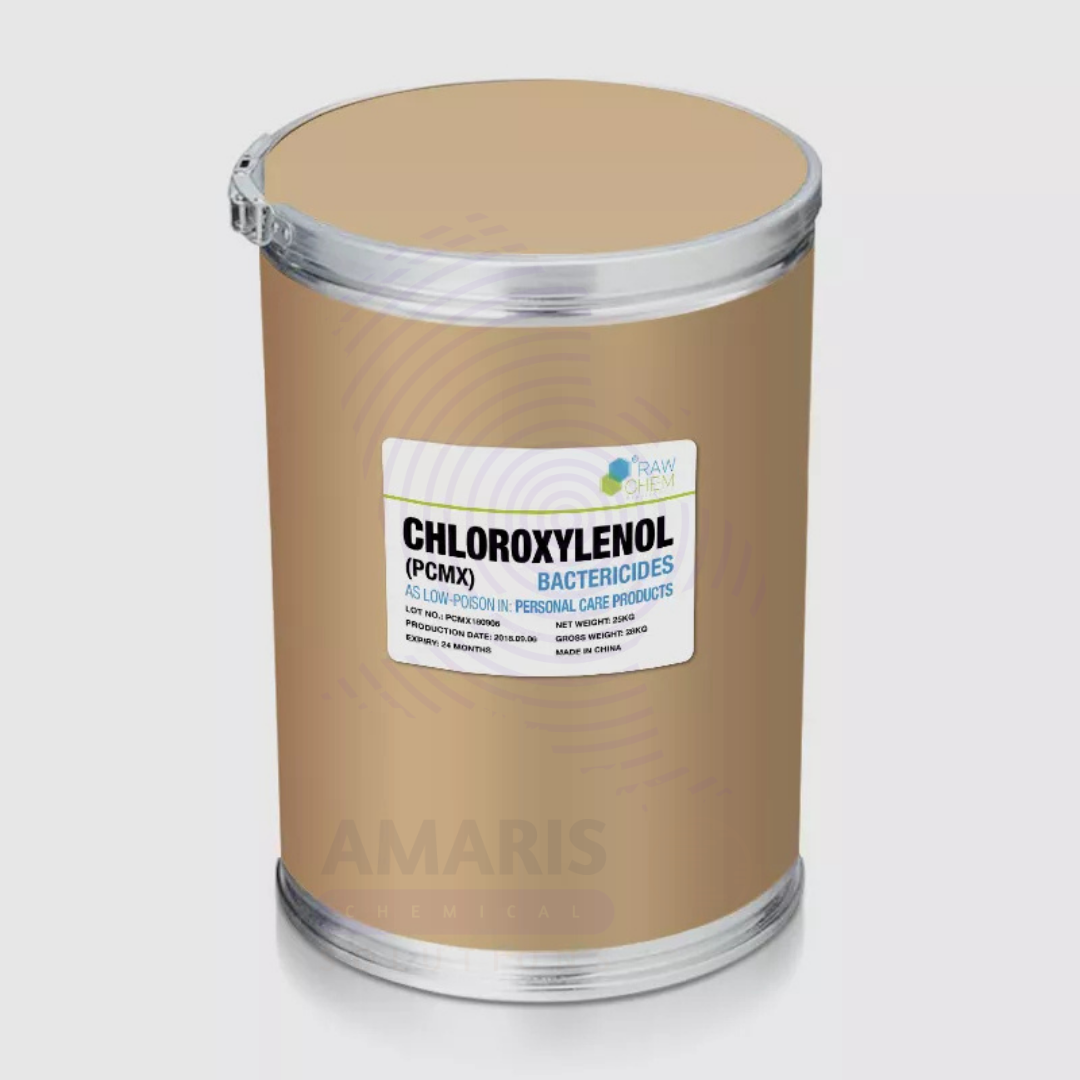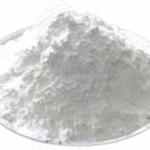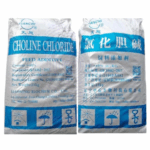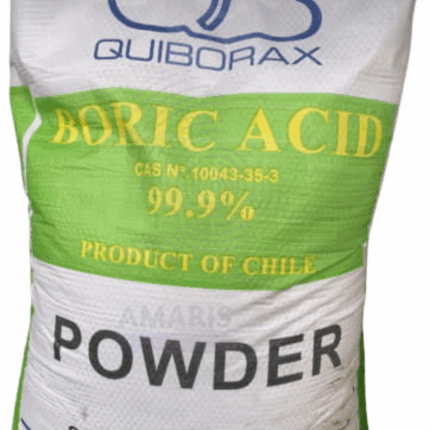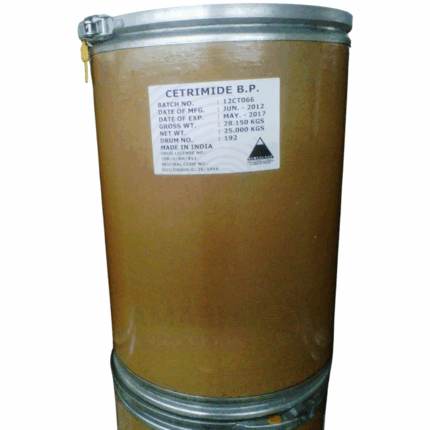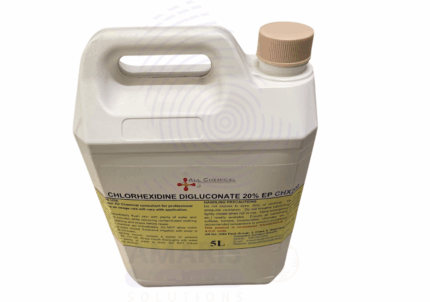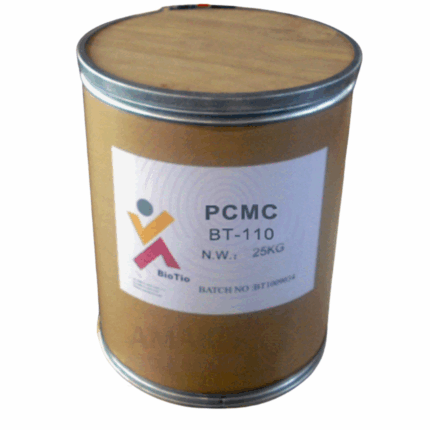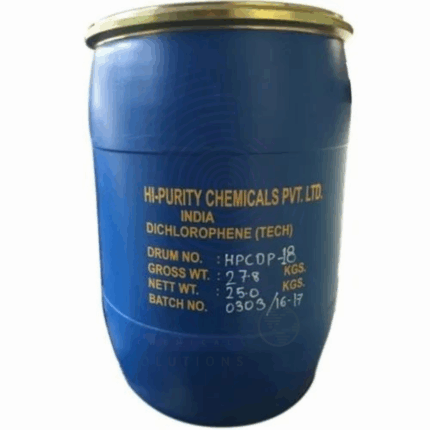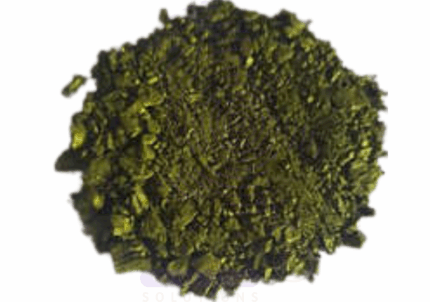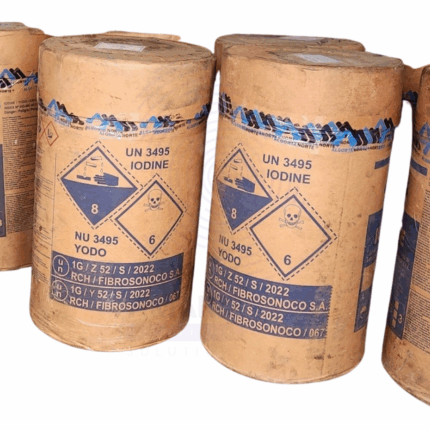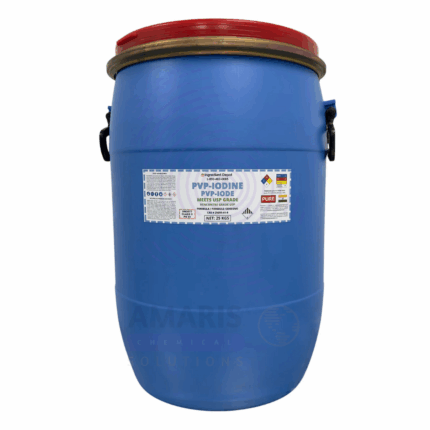Chloroxylenol BP
Whatsapp Order
Chloroxylenol BP is a pale yellow to colorless crystalline solid with a mild phenolic odor. It is a broad-spectrum antimicrobial agent widely used for its bactericidal, fungicidal, and antiviral properties. Chemically known as 4-chloro-3,5-dimethylphenol, Chloroxylenol acts by disrupting microbial cell membranes and inhibiting enzyme systems, making it effective against many gram-positive and some gram-negative bacteria, fungi, and viruses. Its relatively low toxicity and skin irritation profile compared to other phenols have made it a preferred active ingredient in antiseptics, disinfectants, and preservative formulations across pharmaceutical, personal care, household, and industrial applications.
Description
Table of Contents
Toggle
Chloroxylenol BP
Primary Uses
- Pharmaceuticals & Healthcare
- Active ingredient in antiseptic solutions, surgical scrubs, medicated soaps, and wound cleansers for preventing infections.
- Used in topical creams, ointments, and lotions for minor skin infections, cuts, abrasions, and fungal conditions.
- Incorporated in mouthwashes and throat lozenges for antimicrobial and antiseptic benefits.
- Utilized in hospital disinfectants and instrument sanitizers to reduce microbial contamination.
- Household & Institutional Disinfectants
- Key ingredient in surface disinfectants, floor cleaners, and sanitizing sprays for hospitals, clinics, and public spaces.
- Used in hand washes and sanitizers to control spread of pathogens.
- Incorporated in disinfectant wipes and cleaning products to maintain hygiene.
- Personal Care Products
- Included in deodorants and antiseptic skin cleansers to prevent bacterial growth and odor formation.
- Used in formulations requiring broad antimicrobial activity and skin compatibility.
Secondary Uses
- Veterinary Medicine
- Used as an antiseptic and disinfectant in veterinary wound care and skin treatment products.
- Industrial Applications
- Added as a preservative and antimicrobial agent in paints, coatings, and cooling water systems to prevent microbial spoilage.
- Used in wood preservatives to inhibit fungal decay and mold growth.
- Agriculture
- Employed in certain biocidal formulations to control microbial contamination.
- Cosmetics
- Used as a preservative and antimicrobial additive in shampoos, lotions, and other cosmetic products to extend shelf life and prevent contamination.
KEY PRODUCT FEATURES
1. Basic Identification Attributes
- Chemical Name (IUPAC): 4-chloro-3,5-dimethylphenol
- Common/Trade Name: Chloroxylenol, PCMX (Para-Chloro-meta-xylenol)
- CAS Number: 88-04-0
- HS Code: 2907.19.00
- Molecular Formula: C8H9ClO
- Synonyms:
- PCMX
- Para-chloro-meta-xylenol
- Chloroxylenol BP
2. Physical & Chemical Properties
- Physical State: Crystalline solid or flakes
- Color & Odor: Pale yellow to colorless; mild phenolic odor
- Melting Point: 69–74°C
- Boiling Point: Approximately 285°C (decomposes)
- Density: 1.24 g/cm³ at 20°C
- Solubility:
- Slightly soluble in water (~1.2 g/L at 20°C)
- Soluble in ethanol, ether, and other organic solvents
- Stability: Stable under normal conditions; sensitive to light and strong oxidizers
3. Safety & Hazard Attributes
- Hazard Class (GHS): Harmful if swallowed; skin and eye irritant
- NFPA Ratings: Health 2, Flammability 2, Reactivity 0
- Exposure Limits: No specific occupational limits; avoid inhalation and skin contact
- Toxicity: Low to moderate toxicity; safe within recommended use levels
- Reactivity: Stable; avoid mixing with strong oxidizers and acids
4. Storage & Handling Attributes
- Storage Conditions: Store in cool, dry, well-ventilated area away from direct sunlight
- Container Type: Amber glass or HDPE containers with tight seals
- Shelf Life: 2–3 years when stored properly
- Special Handling: Use PPE including gloves, goggles, and masks to avoid dust or vapor exposure
5. Regulatory & Compliance Attributes
- Included in British Pharmacopoeia (BP) standards for antiseptics
- Approved by global regulatory agencies for antiseptic and disinfectant use
- Registered under REACH and other chemical safety frameworks
- Transportation: Not classified as hazardous material for transport under normal conditions
- Waste Disposal: Dispose according to local environmental regulations for phenolic substances
6. Environmental & Health Impact
- Ecotoxicity: Moderately toxic to aquatic life; avoid environmental release
- Persistence: Biodegradable under aerobic conditions, may persist anaerobically
- Bioaccumulation: Low potential
- Carcinogenicity/Mutagenicity: Not classified as carcinogenic or mutagenic
- Biodegradability: Readily biodegradable in the environment
SAFETY HANDLING PRECAUTIONS
Safety Handling Precautions
- PPE: Chemical-resistant gloves, protective eyewear, lab coat/apron, respiratory protection when handling powders or aerosols
- Handling: Avoid inhalation of dust or vapors; use in well-ventilated areas
- Storage: Keep container tightly closed, away from heat, sparks, and sunlight
- Hygiene: Wash hands thoroughly after use; avoid eating, drinking, or smoking during handling
First Aid Measures
- Inhalation: Move victim to fresh air; provide oxygen if breathing is difficult; seek medical attention if symptoms persist
- Skin Contact: Wash affected area with soap and water; seek medical advice if irritation occurs
- Eye Contact: Rinse eyes thoroughly with water for at least 15 minutes; get medical help if irritation continues
- Ingestion: Do not induce vomiting; seek immediate medical assistance
Firefighting Measures
- Fire Hazards: Combustible solid; emits toxic fumes including chlorine-containing compounds and phenols when burned
- Extinguishing Media: Use foam, dry chemical, or carbon dioxide extinguishers
- Special Precautions: Firefighters should wear full protective gear and self-contained breathing apparatus (SCBA)
- Decomposition Products: Carbon monoxide, carbon dioxide, hydrogen chloride, other toxic fumes
Related products
Boric Acid
Boric Acid, chemically known as hydrogen borate or boracic acid, is a weak, monobasic Lewis acid of boron. It appears as a white, crystalline powder or granules that are odorless and slightly soluble in water. Boric Acid is commonly used in antiseptics, insecticides, flame retardants, and as a buffering agent in various industrial and pharmaceutical applications. Due to its mild antiseptic and antifungal properties, it is often used in ophthalmic, dermatologic, and other personal care formulations. It also plays a key role in glass and ceramics manufacturing as well as in agriculture.
Cetrimide Powder
Cetrimide Powder is a high-purity quaternary ammonium compound widely used for its antiseptic, disinfectant, and surfactant properties. It is a cationic surfactant derived from cetyltrimethylammonium bromide and appears as a white to off-white crystalline powder with a slight characteristic odor. Known for its excellent antimicrobial efficacy against bacteria and fungi, cetrimide is frequently incorporated in pharmaceutical, personal care, and industrial formulations. It acts as a bactericidal agent, detergent, and emulsifier, providing effective cleaning and disinfecting action.
Chlorhexidine Digluconate
Chlorhexidine Digluconate is a concentrated aqueous solution of chlorhexidine salt (digluconate form), a potent broad-spectrum antimicrobial agent. It is a clear to slightly yellow viscous liquid with a mild characteristic odor. This antiseptic and disinfectant is widely used in medical, personal care, and industrial applications for its ability to effectively kill bacteria, fungi, and some viruses by disrupting microbial cell membranes. Chlorhexidine Digluconate is valued for its residual antimicrobial activity, low toxicity, and compatibility with various formulations.
Chlorocresol BP
Chlorocresol BP, also known as PCMC (Para-Chlorometa-Cresol), is a white to off-white crystalline powder with a characteristic phenolic odor. It is a chlorinated phenol derivative widely used as a broad-spectrum antimicrobial preservative. It exhibits effective bactericidal and fungicidal activity, making it a preferred preservative in pharmaceutical, cosmetic, and personal care products. Chlorocresol is valued for its stability, solubility in aqueous and alcoholic systems, and compatibility with various formulation types. It helps inhibit microbial growth, thereby enhancing product shelf life and safety.
Dichlorophene Technical
Dichlorophene Technical (also known as 2,2'-Methylenebis(4-chlorophenol)) is a chlorinated phenolic compound used primarily as an antimicrobial agent and disinfectant. It appears as a white to pale yellow crystalline powder with a characteristic phenolic odor. Known for its potent bactericidal and fungicidal properties, Dichlorophene is widely used in pharmaceutical formulations, personal care products, and industrial disinfectants. The “Technical” grade refers to its industrial or bulk purity form used as a raw material in manufacturing.
Gentian Violet Crystals
Gentian Violet Crystals is a dark purple crystalline powder known chemically as Hexamethyl pararosaniline chloride. It is a synthetic triphenylmethane dye historically used for its antimicrobial, antifungal, and antiseptic properties. The “80” typically refers to the dye strength or concentration. Gentian Violet exhibits broad-spectrum antimicrobial activity and is used in medical, veterinary, microbiological, histological, cosmetic, and industrial applications. It functions by disrupting bacterial and fungal cell membranes and inhibiting DNA replication. Despite reduced use in some areas due to safety concerns, it remains valuable in certain low-cost, traditional, and veterinary applications.
Iodine Crystals
Iodine Crystals are high-purity elemental iodine in solid crystalline form. These dark violet-black crystals have a characteristic pungent odor and sublime easily at room temperature, releasing violet iodine vapors. Iodine is a halogen element widely used for its antiseptic, oxidizing, and chemical reagent properties in pharmaceutical, industrial, and laboratory applications.
PVP Iodine
PVP Iodine is a water-soluble complex of polyvinylpyrrolidone (PVP) and iodine, widely used as a broad-spectrum antiseptic. It delivers controlled iodine release, providing effective antimicrobial action against bacteria, viruses, fungi, and protozoa. This preparation is favored for its ease of application, reduced irritation compared to tinctures, and stability in aqueous solutions. PVP Iodine 10% is commonly used in medical, veterinary, and personal care settings for disinfection and wound treatment.


 Preservatives(food)
Preservatives(food) Flavor Enhancers
Flavor Enhancers Acidulants
Acidulants Sweeteners
Sweeteners Antioxidants
Antioxidants Colorants(food)
Colorants(food) Nutraceutical Ingredients (food)
Nutraceutical Ingredients (food) Nutrient Supplements
Nutrient Supplements Emulsifiers
Emulsifiers
 Collectors
Collectors Dust Suppressants
Dust Suppressants Explosives and Blasting Agents
Explosives and Blasting Agents Flocculants and Coagulants
Flocculants and Coagulants Frothers
Frothers Leaching Agents
Leaching Agents pH Modifiers
pH Modifiers Precious Metal Extraction Agents
Precious Metal Extraction Agents
 Antioxidants(plastic)
Antioxidants(plastic) Colorants (Pigments, Dyes)
Colorants (Pigments, Dyes) Fillers and Reinforcements
Fillers and Reinforcements Flame Retardants
Flame Retardants Monomers
Monomers Plasticizers
Plasticizers Polymerization Initiators
Polymerization Initiators Stabilizers (UV, Heat)
Stabilizers (UV, Heat)
 Antifoaming Agents
Antifoaming Agents Chelating Agents
Chelating Agents Coagulants and Flocculants
Coagulants and Flocculants Corrosion Inhibitors
Corrosion Inhibitors Disinfectants and Biocides
Disinfectants and Biocides Oxidizing Agents
Oxidizing Agents pH Adjusters
pH Adjusters Scale Inhibitors( water)
Scale Inhibitors( water)
 Antioxidants(cosmetic)
Antioxidants(cosmetic) Emollients
Emollients Fragrances and Essential Oils
Fragrances and Essential Oils Humectants
Humectants Preservatives
Preservatives Surfactants(cosmetic)
Surfactants(cosmetic) Thickeners
Thickeners UV Filters
UV Filters
 Fertilizers
Fertilizers Soil Conditioners
Soil Conditioners Plant Growth Regulators
Plant Growth Regulators Animal Feed Additives
Animal Feed Additives Biostimulants
Biostimulants Pesticides (Herbicides, Insecticides, Fungicides)
Pesticides (Herbicides, Insecticides, Fungicides)
 Active Pharmaceutical Ingredients (APIs)
Active Pharmaceutical Ingredients (APIs) Excipients
Excipients Solvents(pharmaceutical)
Solvents(pharmaceutical) Antibiotics
Antibiotics Antiseptics and Disinfectants
Antiseptics and Disinfectants Vaccine Adjuvants
Vaccine Adjuvants Nutraceutical Ingredients (pharmaceutical)
Nutraceutical Ingredients (pharmaceutical) Analgesics & Antipyretics
Analgesics & Antipyretics
 Analytical Reagents
Analytical Reagents Solvents(lab)
Solvents(lab) Chromatography Chemicals
Chromatography Chemicals Spectroscopy Reagents
Spectroscopy Reagents microbiology-and-cell-culture-reagents
microbiology-and-cell-culture-reagents Molecular Biology Reagents
Molecular Biology Reagents Biochemical Reagents
Biochemical Reagents Inorganic and Organic Standards
Inorganic and Organic Standards Laboratory Safety Chemicals
Laboratory Safety Chemicals Specialty Laboratory Chemicals(Special Laboratory Equipment)
Specialty Laboratory Chemicals(Special Laboratory Equipment)
 Demulsifiers
Demulsifiers Hydraulic Fracturing Fluids
Hydraulic Fracturing Fluids Scale Inhibitors(oil)
Scale Inhibitors(oil) Surfactants(oil)
Surfactants(oil) Drilling Fluids
Drilling Fluids
 Dyes and Pigments
Dyes and Pigments Bleaching Agents
Bleaching Agents Softening Agents
Softening Agents Finishing Agents
Finishing Agents Antistatic Agents
Antistatic Agents
 Admixtures
Admixtures Waterproofing Agents
Waterproofing Agents Sealants and Adhesives
Sealants and Adhesives Curing Compounds
Curing Compounds Concrete Repair Chemicals
Concrete Repair Chemicals Anti-Corrosion Coatings
Anti-Corrosion Coatings
 Surfactants(cleaning)
Surfactants(cleaning) Builders
Builders Enzymes
Enzymes Solvents (Cleaning)
Solvents (Cleaning) Fragrances
Fragrances
 Electronic Chemicals
Electronic Chemicals Catalysts
Catalysts Lubricants
Lubricants Photographic Chemicals
Photographic Chemicals Refrigerants
Refrigerants Automotive chemicals
Automotive chemicals Pyrotechnic Chemicals
Pyrotechnic Chemicals
 Biodegradable Surfactants
Biodegradable Surfactants Bio-based Solvents
Bio-based Solvents Renewable Polymers
Renewable Polymers Carbon Capture Chemicals
Carbon Capture Chemicals Wastewater Treatment Chemicals
Wastewater Treatment Chemicals
 Pigments
Pigments Solvents(paint)
Solvents(paint) Specialty Coatings
Specialty Coatings Binders/Resins
Binders/Resins Additives
Additives Driers
Driers Anti-Corrosion Agents
Anti-Corrosion Agents Functional Coatings
Functional Coatings Application-Specific Coatings
Application-Specific Coatings
 Fresh Herbs
Fresh Herbs Ground Spices
Ground Spices Whole Spices
Whole Spices Spice Blends
Spice Blends Dried Herbs
Dried Herbs
 Leavening Agents
Leavening Agents Dough Conditioners
Dough Conditioners Flour Treatments
Flour Treatments Fat Replacers
Fat Replacers Decoratives
Decoratives Preservatives(baking)
Preservatives(baking)
 Plasticizers & Softeners
Plasticizers & Softeners Reinforcing Agents
Reinforcing Agents Adhesion Promoters
Adhesion Promoters Vulcanizing Agents
Vulcanizing Agents Antidegradants
Antidegradants Blowing Agents
Blowing Agents Fillers & Extenders
Fillers & Extenders Accelerators & Retarders
Accelerators & Retarders